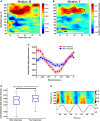Coupled oscillations orchestrate selective information transmission in visual cortex
- PMID: 39161729
- PMCID: PMC11331424
- DOI: 10.1093/pnasnexus/pgae288
Coupled oscillations orchestrate selective information transmission in visual cortex
Abstract
Performing visually guided behavior involves flexible routing of sensory information towards associative areas. We hypothesize that in visual cortical areas, this routing is shaped by a gating influence of the local neuronal population on the activity of the same population's single neurons. We analyzed beta frequencies (representing local population activity), high-gamma frequencies (representative of the activity of local clusters of neurons), and the firing of single neurons in the medial temporal (MT) area of behaving rhesus monkeys. Our results show an influence of beta activity on single neurons, predictive of behavioral performance. Similarly, the temporal dependence of high-gamma on beta predicts behavioral performance. These demonstrate a unidirectional influence of network-level neural dynamics on single-neuron activity, preferentially routing relevant information. This demonstration of a local top-down influence unveils a previously unexplored perspective onto a core feature of cortical information processing: the selective transmission of sensory information to downstream areas based on behavioral relevance.
Keywords: high-gamma oscillations; local field potentials; macaque visual area MT; neural oscillations; phase-amplitude coupling (PAC).
© The Author(s) 2024. Published by Oxford University Press on behalf of National Academy of Sciences.
Figures







Similar articles
-
Phase of neural oscillations as a reference frame for attention-based routing in visual cortex.Prog Neurobiol. 2024 Feb;233:102563. doi: 10.1016/j.pneurobio.2023.102563. Epub 2023 Dec 23. Prog Neurobiol. 2024. PMID: 38142770
-
Attention Configures Synchronization Within Local Neuronal Networks for Processing of the Behaviorally Relevant Stimulus.Front Neural Circuits. 2018 Aug 29;12:71. doi: 10.3389/fncir.2018.00071. eCollection 2018. Front Neural Circuits. 2018. PMID: 30210309 Free PMC article.
-
Routing information flow by separate neural synchrony frequencies allows for "functionally labeled lines" in higher primate cortex.Proc Natl Acad Sci U S A. 2019 Jun 18;116(25):12506-12515. doi: 10.1073/pnas.1819827116. Epub 2019 May 30. Proc Natl Acad Sci U S A. 2019. PMID: 31147468 Free PMC article.
-
Attention Decreases Phase-Amplitude Coupling, Enhancing Stimulus Discriminability in Cortical Area MT.Front Neural Circuits. 2015 Dec 22;9:82. doi: 10.3389/fncir.2015.00082. eCollection 2015. Front Neural Circuits. 2015. PMID: 26733820 Free PMC article.
-
Phase correlation among rhythms present at different frequencies: spectral methods, application to microelectrode recordings from visual cortex and functional implications.Int J Psychophysiol. 1997 Jun;26(1-3):171-89. doi: 10.1016/s0167-8760(97)00763-0. Int J Psychophysiol. 1997. PMID: 9203002 Review.
Cited by
-
Focal Infrared Neural Stimulation Propagates Dynamical Transformations in Auditory Cortex.bioRxiv [Preprint]. 2025 Mar 16:2025.03.12.642906. doi: 10.1101/2025.03.12.642906. bioRxiv. 2025. PMID: 40161605 Free PMC article. Preprint.
-
Perceptual Decision Efficiency Is Modifiable and Associated with Decreased Musculoskeletal Injury Risk Among Female College Soccer Players.Brain Sci. 2025 Jul 4;15(7):721. doi: 10.3390/brainsci15070721. Brain Sci. 2025. PMID: 40722312 Free PMC article.
References
LinkOut - more resources
Full Text Sources

